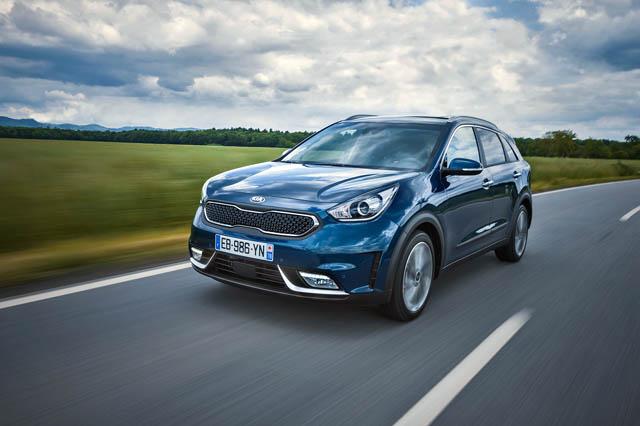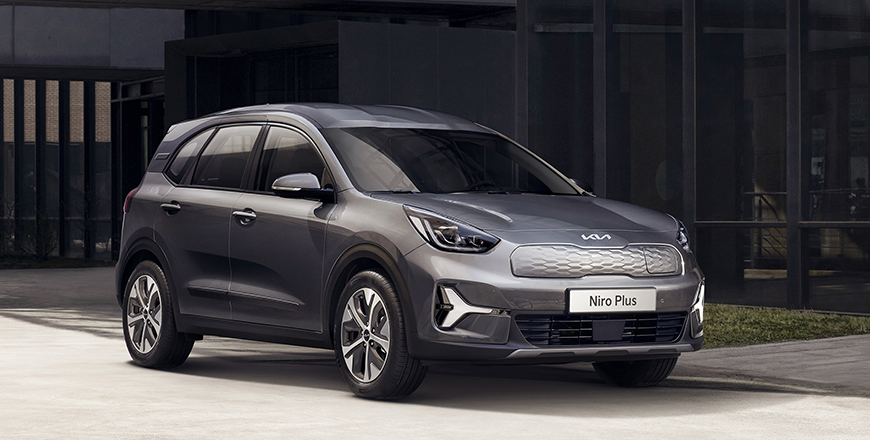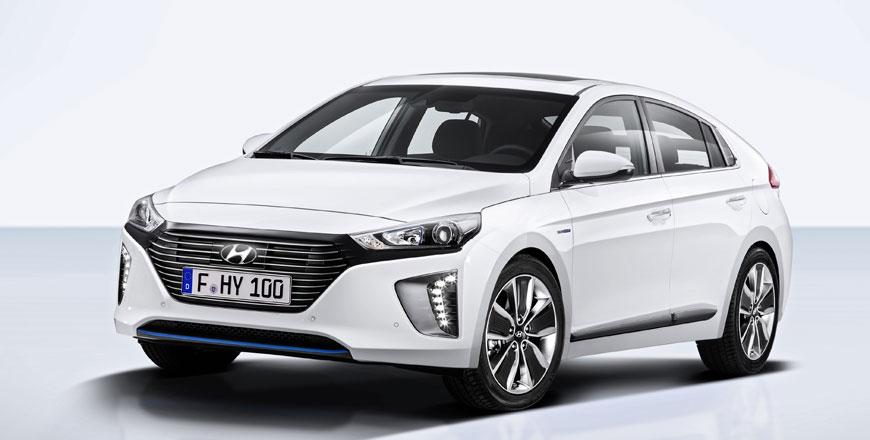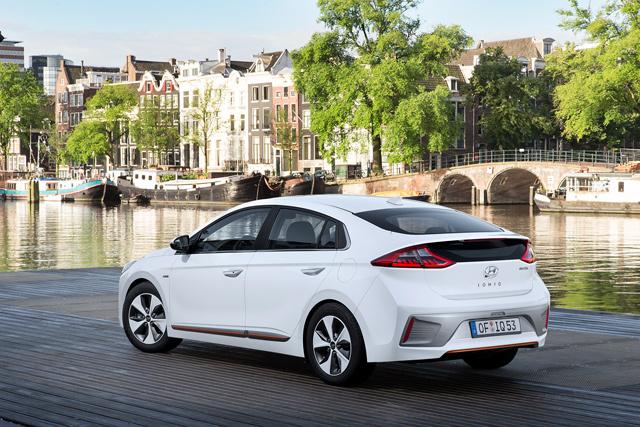You are here
Kia Niro: Hybrid hero!?
By Ghaith Madadha - Jun 13,2017 - Last updated at Jun 13,2017

Photo courtesy of Kia
At a casual and distant glance one could be forgiven for mistaking the Kia Niro for a compact crossover SUV (CUV), perhaps a somewhat more assertive looking derivative of the Kia Sportage, to which bears strong familial resemblance. A purpose built petrol-electric hybrid that shares much with its Hyundai Ioniq saloon cousin, the Niro is instead a practical segment-bending vehicle. Expected to be popular in the fuel consumption-sensitive Jordanian market, the Niro is somewhere between CUV and MPV, yet is based on and competes with hybrid cars like the aforementioned Ioniq and the ubiquitous Toyota Prius, among others.
Aggressive aesthetic
A far cry from the dramatic, tense and urgently pouncing CUV-coupe Niro concept unveiled at the 2013 Frankfurt motor show with up-tilting ‘‘butterfly’’ doors, the production version — launched as a 2017 model — is a much more sensible and practical family vehicle.
Retaining much of the concept’s styling cues, the production Niro features a similarly slim and moody ‘‘tiger’’ grille flanked by swept back diamond-like headlights and sitting atop an aggressive bumper assembly with big intakes. A rising waistline and rakishly descending roofline converge towards high-set rear lights, similar to the Niro concept, while black lower cladding lends a rugged SUV flavour.
Not one to wear its hybrid credentials overtly on its sleeve in terms of aesthetic, the Niro’s design approach is contrary to its Ioniq cousin, and is instead designed to be more aggressive and to have a certain visceral appeal to a wider audience and more mainstream audience.
Not to be pigeonholed into a strict segment, the Niro is for the most part a CUV with its raised ride and aggressive body style, albeit one that is exclusively front-wheel-drive, and without much off-road aspiration. Alternatively, the Niro also has disguised hints of a versatile and spacious MPV, not too unlike the larger Kia Carens.
Efficient and flexible
Designed from ground up — rather than converted — for hybrid application, the Niro’s electric motors, hybrid components are well-integrated, positioned for better weight distribution. Its efficiently charging lithium-ion batteries are 20 per cent lighter than competitors, while increased use of lightweight and high strength components in construction offsets the hybrid system’s weight and aids efficiency, safety ride and handling.
Under the bonnet, the Niro’s thermally efficient but somewhat low-revving Atkinson cycle direct injection 1.6-litre four-cylinder engine produces 103BHP at 5700rpm and 108lb/ft at 4000rpm, Mated to an electric motor developing 43BHP and 125lb/ft, the Niro’s maximum combined system output is 139BHP and 195lb/ft.
Driving the front wheels through petrol and electric motors working in unison or individually, depending on conditions, throttle input and battery charge, the Niro is quicker than power figures suggest, with its electric motor’s ample torque allowing for confident flexibility at any engine speed.
Responsive from standstill and particularly versatile at city and highway cruising speeds, the Niro is capable of 0-100km/h acceleration in 11.5-seconds and returns frugal 4.4l/100km combined fuel efficiency. Slightly down on the more aerodynamic Ionic’s official efficiency figures, one, however, expects real world efficiency figures, even on demanding Jordanian roads, to be similar to Kia’s official figures.
Smooth and integrated
Smoother and better integrated than some predecessors, especially on throttle lift-off response when driven hard, it is only at very low speed that one occasionally notices a slight nudge from the two motors integrating. Capable of a conservatively quoted 162km/h top speed (estimated to be 170-180km/h) the Niro drives briefly on electric-only mode at around 120km/h, while battery charge and discharge times impressed, even on inclines. However, when battery charge depletes on sustained steep inclines, the otherwise refined petrol engine is left to its own devices, and feels somewhat strained at high revs, while acceleration drops somewhat until batteries recharge again from the combustion engine and regenerative braking system.
Riding on MacPherson strut front and multi-link rear suspension, the Niro felt refined and mostly forgiving on Jordanian roads, even with low profile 225/45R18 tyres. Slightly firm over rougher and more sudden road imperfections, the Niro was smooth, stable and refined on highway, with rigid construction evident.
Through winding country roads the Niro performed well for its CUV segment, and was happy to be hustled along briskly but not pushed right to the limits of its power and dynamic abilities. Turning in tidily with just little understeer if pushed too hard, one, however, needs to dial in throttle input smoothly to prevent torque steer owing to its generous output.
Spacious and smooth
Quick and direct if not especially textured or nuanced for road feel, the Niro’s electric-assisted steering felt positive with good self-centring through corners, while body lean was controlled well when the Niro settles into a corner. Through corners grip was good, with slippage caught easily by electronic stability controls when mechanical road-holding limits were exceeded. Well concealing its hybrid system’s weighting, the Niro’s handling felt easily adjustable on torque steer with slight lift-off and through corners with a slight weigh pivot. Meanwhile its slick 6-speed automated dual clutch gearbox provided more driver control than some competitor’s elastic-feeling continuously variable transmissions.
Well thought out and executed, the Niro builds on Kia’s previous hybrid experience, and with handsome CUV design, almost MPV-like practicality and roominess, fuel efficiency and pricing would be expected to do well in Jordan once the nameplate catches on.
Reasonably priced, the Niro features a spacious cabin with more soft textures and equipment than some rivals. Well-equipped and with uncluttered and user-friendly layouts, the Niro’s wide swinging doors allow easy access. Cabin space is very good, with rear headroom especially generous compared to rivals. Seating is comfortable and well adjustable and with lumbar support, visibility is good and aided by a rearview camera, while luggage room is generous and expandable.
TECHNICAL SPECIFICATIONS
Engine: petrol/electric hybrid, 1.6-litre, transverse, 4-cylinders
Bore x stroke: 72 x 97mm
Compression ratio: 13:1
Valve-train: 16-valve, DOHC
Gearbox: 6-speed automated dual clutch, front-wheel-drive
Gear ratios: 1st 3.867; 2nd 2.217; 3rd 1.371; 4th 0.93; 5th 0.956; 6th 0.767; R 5.351
Final drive, gears 1-4
/5-6, R: 4.438/3.227/
Power – petrol engine, BHP (PS) [kW]: 103.5 (105) [77.2] @5700rpm
Power – electric motor, BHP (PS) [kW]: 42.9 (43.5) [32]
Power – combined, BHP (PS) [kW]: 139 (141) [104] @5700rpm
Torque – petrol engine, lb/ft (Nm): 108 (147) @4000rpm
Torque – electric motor, lb/ft (Nm): 125 (170)
Torque – combined, lb/ft (Nm): 195 (265) @4000rpm
Battery type, capacity, voltage: Lithium-ion polymer, 1.56kwh, 240v
0-100km/h: 11.5-seconds
Top speed: 162km/h
Fuel consumption, city/highway/combined: 4.5-/4.4-/4.4-litres/100km
CO2 emissions: 101g/km
Fuel capacity: 45-litres
Length: 4355mm
Width: 1805mm
Height: 1535mm
Wheelbase: 2700mm
Track, F/R: 1555/1569mm
Overhang, F/R; 870/785mm
Headroom, F/R: 1049/993mm
Legroom, F/R: 1117/950mm
Shoulder room, F/R: 1423/1402mm
Cargo volume, min/max: 427/1425-litres
Approach/departure angles: 17.3°/29.2°
Unladen weight: 1425kg
Suspension, F/R: MacPherson struts/multi-link, anti roll bars
Steering: Electric-assisted, rack and pinion
Lock-to-lock: 2.66-turns
Turning circle: 10.6-metres
Brakes, F/R: Ventilated discs/discs, regenerative braking
Tyres: 225/45R18
Price, as tested: JD23,500 (on-the-road, comprehensive insurance)
Related Articles
Introduced globally early last year, the Kia Niro Plus arrived just months after the late 2021 launch of an all-new second generation
Launched in recent months and taking aim squarely at the Toyota Prius, the Hyundai Ioniq is the Korean giant’s first purpose-built, petrol-e
Designed specifically for electrification rather than adapted from a regular combustion engine model, the Hyundai Ioniq is offered in three














